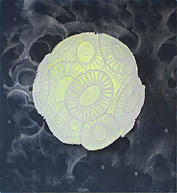Making the invisible visible
Ellen Karin Mæhlum’s Plancton Portraits are hanging on several floors at the Department of Biology. The beautiful prints are a magnified, aesthetical twist on images that many of the department’s researchers know from their microscopes.
Main content
Have you ever seen plankton? Of course you have – in a sense. Plankton follows the ocean currents and is present everywhere in the sea. But the plankton tend to be microscopic organisms that cannot be spotted with the naked eye. Despite their tiny size, phytoplankton play a major role in our climate. They produce oxygen from CO2 in the same way as do plants on land.
Ellen Karin Mæhlum’s Plankton Portraits are magnified more than 30 000 times, based on photographs of plant and animal plankton that are a few microns wide (a micron is one thousandth of a millimeter). Organisms that we cannot normally see are in the silk prints made not only visible, but monumental. The very fact that they are called "portraits", a word usually reserved for representations of people, bestows dignity upon the individual plankton. And the plankton deserve all the space they can get. The fascinating structures on display are both aesthetically beautiful, and interesting for those who are concerned with the workings of nature.
Ellen Karin Mæhlum (1957-) works mainly with graphic prints. Since 2003, she has been collaborating with geologists from the University of Oslo, resulting in the series Geoprints. Similarly, her Plankton portraits were made in collaboration with biologists from the University of Bergen. She also donated some of her geoprints to the University. Mæhlum is represented at a number of Norwegian embassies. In addition to her artistic work, she holds courses in graphics, and has collaborated with the Circa Theatre in Trondheim on several productions.
NORA SØRENSEN VAAGE






